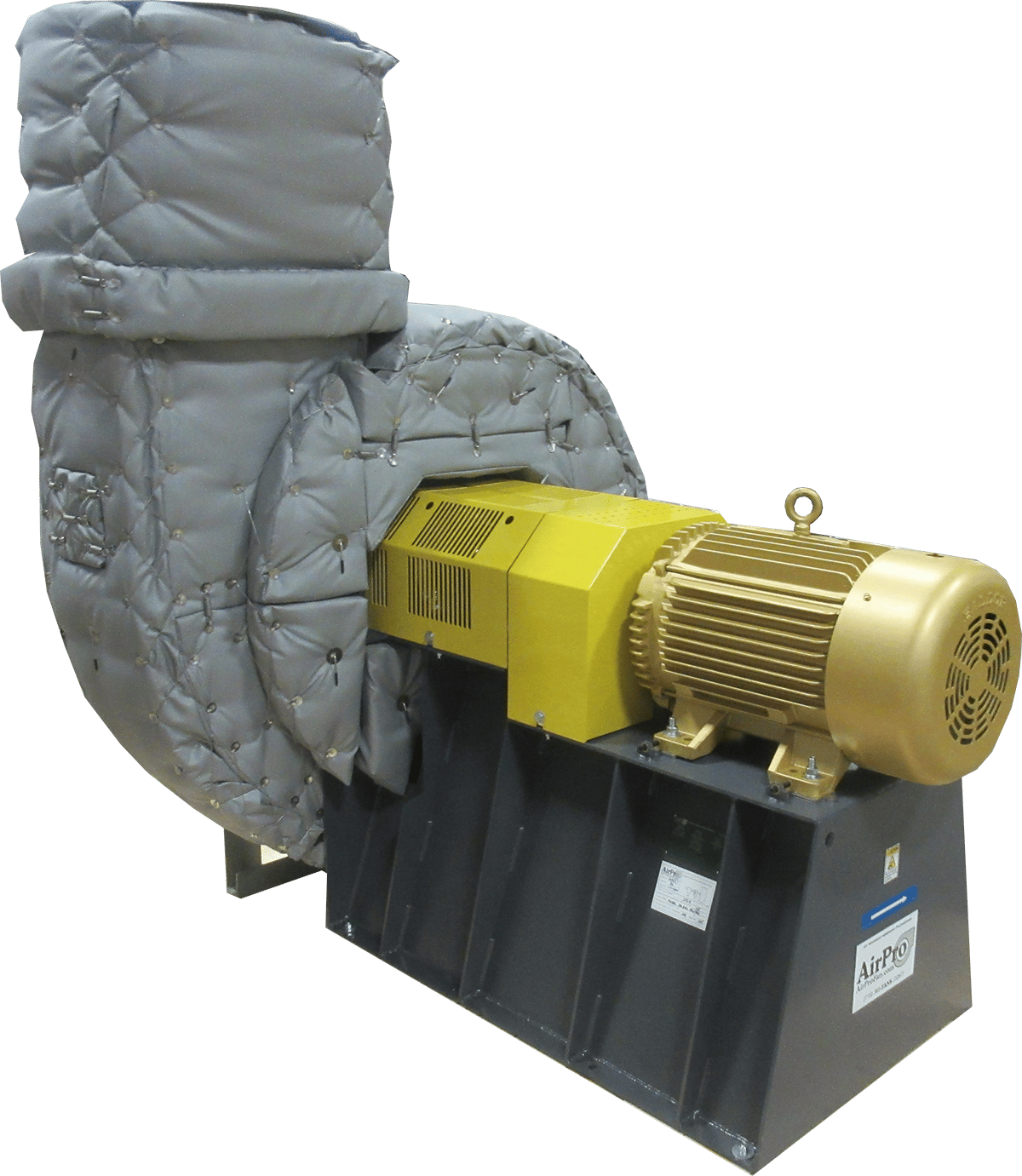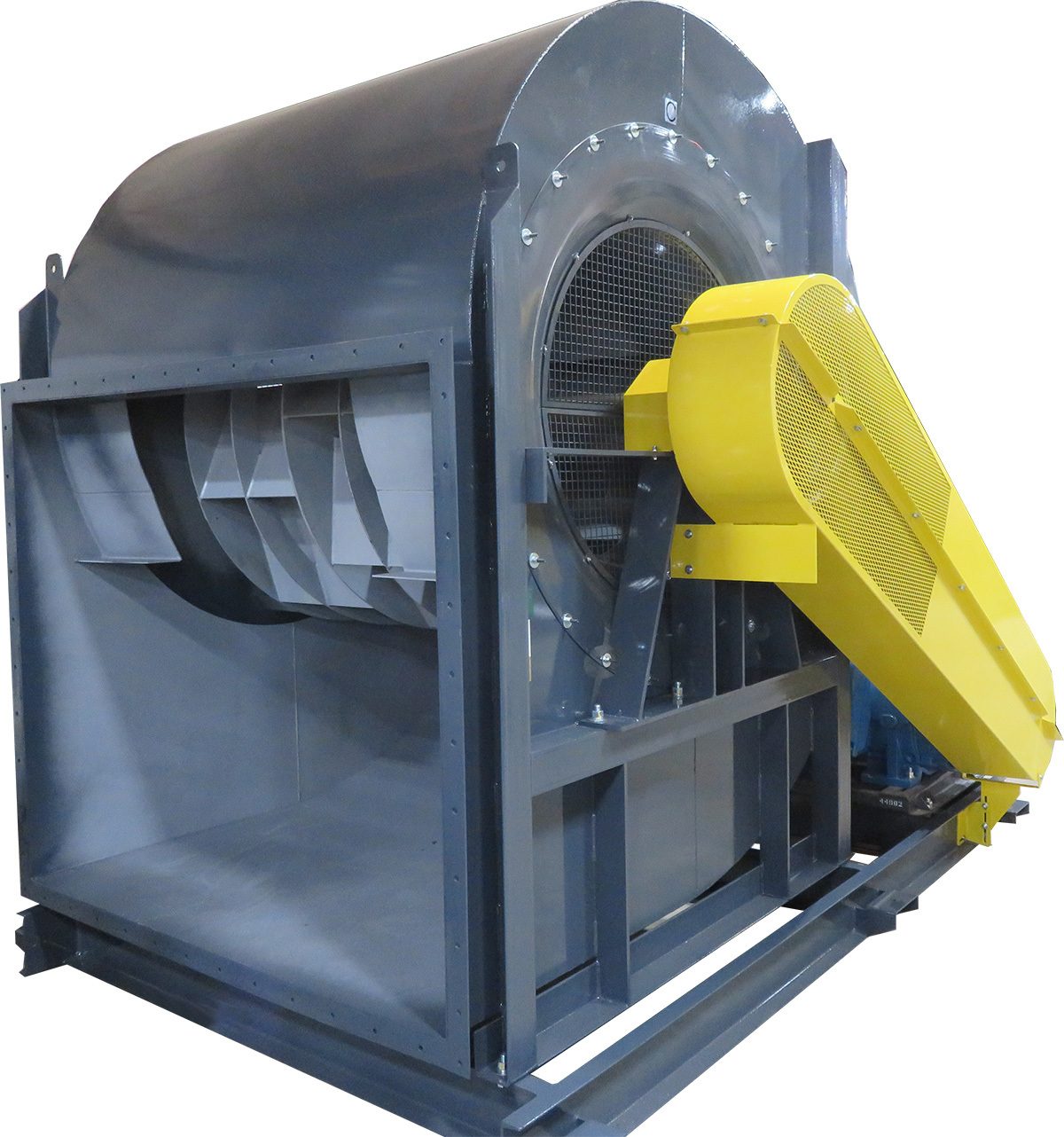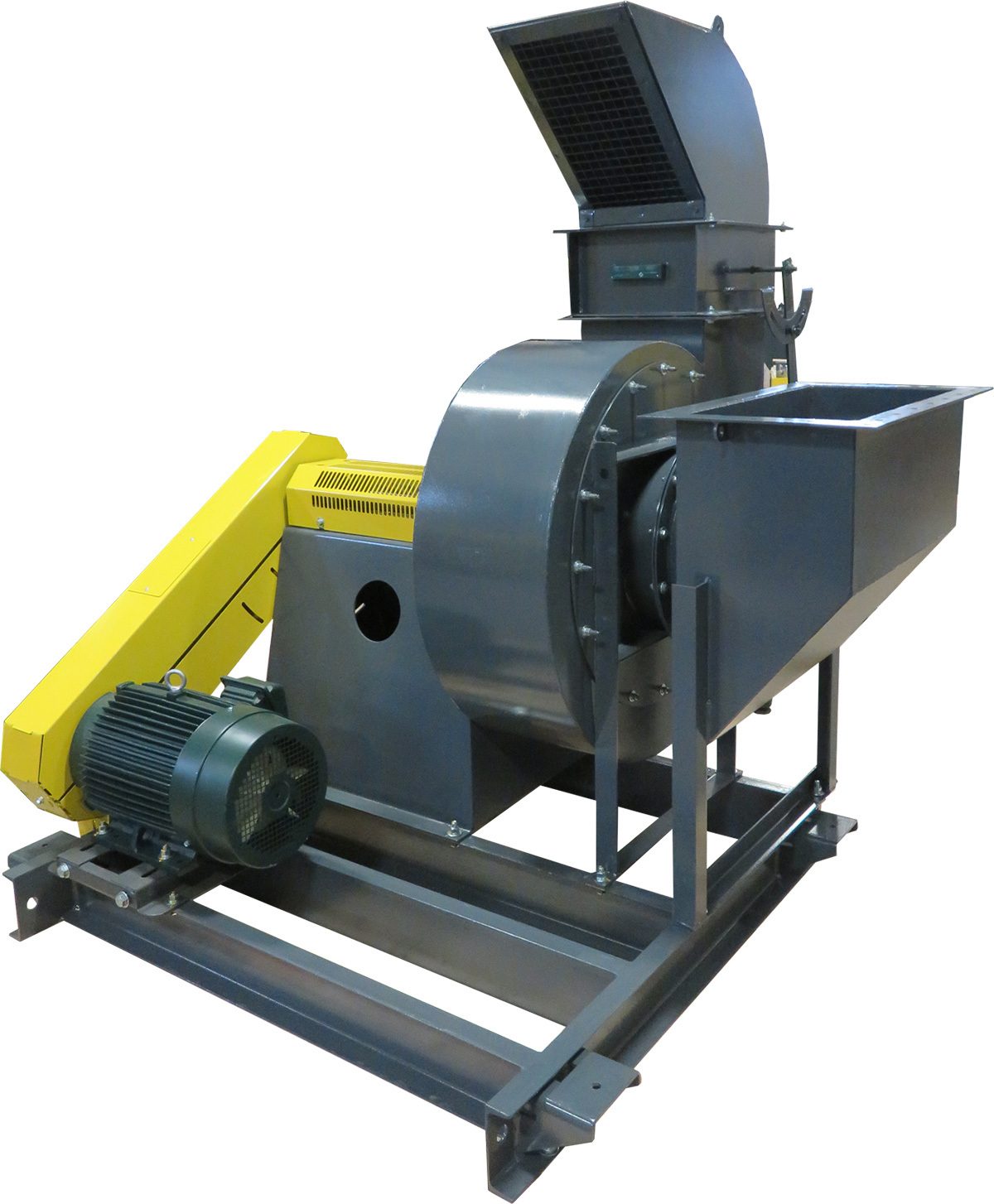
For process cooling applications, there are several industrial fan options. A cooling blower for use in a bioenergy plant is shown.
Maintenance Tips
for Process Cooling Centrifugal Fans
All images provided by AirPro Fan & Blower Co. unless otherwise noted
background video: alexey_boldin / Creatas Video+ / Getty Images Plus
By Chet White,
AirPro Fan & Blower Co.
Industrial Fans
Following these 20 tips will help extend the life of your industrial fan and safeguard operational safety, efficiency and productivity.
The moving parts of centrifugal fans — and the vital role that fans play in many industrial process cooling applications — make them critical components for maintenance considerations. But, how do you ensure that your industrial fans have long operating lives while running safely, efficiently and productively?
We’ve identified 20 tips across three stages of life for an industrial fan that will set you up for optimal operations in your process cooling system. The three stages are:
- Design and construction.
- Storage and installation.
- Operations and service.
Careful consideration of the tips across all three stages will allow you to maximize the life of your fan, reduce your overall maintenance costs and keep your process cooling operations flowing smoothly.
The moving parts of centrifugal fans — and the vital role that fans play in many industrial process cooling applications — make them critical components for maintenance considerations. But, how do you ensure that your industrial fans have long operating lives while running safely, efficiently and productively?
We’ve identified 20 tips across three stages of life for an industrial fan that will set you up for optimal operations in your process cooling system. The three stages are:
- Design and construction.
- Storage and installation.
- Operations and service.
Careful consideration of the tips across all three stages will allow you to maximize the life of your fan, reduce your overall maintenance costs and keep your process cooling operations flowing smoothly.
Tips for Fan Design and Construction
Considering maintenance during the design and construction stage for industrial fans means you are ahead of the game. There are six things you can do during industrial fan design and construction to help ensure a long centrifugal fan life.
1. Select the Right Fan for the Airstream
For process cooling applications, there are several industrial fan options. These include:
- Backward-curved fans to handle clean air or light particulate and deliver high efficiency at high volume with high pressure.
- Backward-inclined fans to process clean air at normal-to-high temperatures in high volume, low pressure applications.
- High pressure radial fans to withstand abrasive airstreams and material handling.
- Industrial exhausters to process saturated gas, light particulates and clean dry gas at a lower cost.
Usually, a few options with various trade-offs must be considered. Be sure you have the right application engineer insights to help you select the fan that will set you up for low maintenance operations as well as optimal performance.
2. Specify the Right Accessories to Protect Your Fan
The accessories you specify for your industrial fan can make all the difference in favor of your success with fan maintenance. Every process cooling system has a unique environment. Some may have more or fewer constraints on space; others may have foundational or temperature challenges. Accessories can help with important maintenance drivers like vibration, temperature, power fluctuations and fan surroundings. Accessory options include vibration and temperature sensors, auto-lubricators, vibration isolators and expansion joints.
3. Design Your Fan Housing with Appropriate Access and Flexibility
The fan housing can be a blessing or a curse when it comes to maintenance. The “secret” is to design the housing with access features based on the specific positioning of the fan and your need to access the housing interior. Different types of doors provide access inside the housing to the fan wheel. Split-housing designs enable wheel removal without disrupting ductwork, and rotatable housing options allow for configuration adjustments in the field.
4. Use the Right Materials for Your Application
Make sure your process cooling fan is built with the materials of construction that will save you from premature wear-and-tear and maintenance issues in the near and long term.
Depending on your facility and process, you may need aluminum for spark resistance, stainless steel for corrosion protection, or special alloys to withstand high temperatures. Provide your supplier with the specifics of your application; then, make sure they know not only what will work, but also what will keep you safe and compliant with all relevant standards and regulations.
5. Watch for Good Welding
Fans include multiple rotating components that are welded together. That makes weld quality a critical factor in reliable and safe operation. You may want to ensure that your fan manufacturer is using weld processes that comply with applicable industry standards.
Weld testing also is available to verify structural integrity. Depending on your application, it may be appropriate.
6. Start with the Right Finishes
Use the best finishes and coatings to make your fans resistant to corrosion, heat, fire, particles and other elements. Custom finish options are diverse and include various enamels, specialty paints and linings. They may simplify routine maintenance and increase the life of your fan.

Making sure your process cooling fan is built with the right materials of construction will help avoid premature wear-and-tear and maintenance issues. This might include spark-resistant materials, stainless steel for corrosion protection, or special alloys to withstand high temperatures.
Tips for Fan Storage and Installation
Once your industrial fan is built and shipped, there are seven maintenance tips to keep it in good shape for the start of your process cooling operations. But first, there is one item that is both too obvious — and too important — to call a “tip.” Always be sure to follow the fan manufacturer’s installation, operation and maintenance (IOM) manual for installation.
Here are the tips for industrial fan maintenance at the storage and installation stage.
7. Select Your Storage Spot Carefully
If you need to store your fan for any length of time prior to installation, which is common, it is essential to pick the right spot. Make sure it is in a clean, protected area, isolated from vibrations that can damage the fan and its motor bearings.
8. Release Motor Belt Tensions
If your fan has a belt drive and you need to store it for a prolonged period, be sure to release the belt tensions. Also, do not forget to retighten them when you are ready to install.
9. Rotate Weekly
When storing an industrial fan, it is critical to rotate the fan wheel by hand at least once a week to prevent the shaft from taking a set, and to redistribute the bearing grease. Rotate the motor and rotor at the same time to ensure all bearing parts are well greased.
10. Start with a Secure, Level Foundation
When it is time to install the fan, make sure you have a strong, level surface like reinforced concrete to support the weight and balance of the heavy-duty machinery. Also, it should be rigid enough to withstand the maximum allowed vibration levels indicated in the IOM. Be sure to fasten the fan securely to the foundation with the specified amount of torque.
11. Check for Imbalances and Excess Vibration
Because fan balance is vital to a smooth startup, if the fan had to sit idle for any length of time before installation, you will want to check the balance and vibration levels. Check for and correct imbalances and excess vibration to operate within the safe levels provided by your fan manufacturer. That can include things like adding vibration isolators or installing flexible connections between the fan connections and ductwork.
12. Tighten and Align
Check all alignments to ensure they remain within the manufacturer’s tolerances. Be sure all of the fasteners, particularly the ones in the wheel connection to the shaft, are appropriately tight. If they are not, failure might not be far behind.
13. Double-Check Bearing Lubrication
You want there to be just enough lubrication — not too much and not too little — evenly distributed in the bearings to allow smooth operation without leaking. This is a common maintenance area, so it is best to start on the right foot.

The moving parts of centrifugal fans and the vital role they play in many industrial process cooling applications make them critical components for maintenance considerations.
Operations and Service Tips
If you have followed the previously mentioned steps, you have set yourself up with the potential for a long fan life that lasts well beyond most manufacturer’s warranties. But that does not mean your maintenance work is finished. In fact, you have only just begun.
The final seven tips for industrial fan maintenance should serve as a standing list of regular checks and repairs of key components such as the motor, the fan and any related accessories and connections. Timing will vary across process cooling fan applications. This maintenance requires discipline, but it requires much less cost and effort than would be required if you skip these simple but vital steps.
14. Install Sensors
We recommend temperature and vibration sensors to provide continuous monitoring for the early detection of problems. Sensors provide an early warning of potential issues so you can address them before they become catastrophic. Do not forget about your motor bearings when you are installing and monitoring your sensors.
15. Check Your Bearings
Bearings are among the most frequently replaced items on an industrial fan. If you extend the life of your bearings through proper maintenance, you will save on the cost of otherwise more frequent replacements. It will also help extend the life of the overall process cooling fan and system. As noted above, this includes ongoing monitoring for vibration and temperature as well as proper lubrication to reduce friction while still releasing heat.
Do not forget that no matter how good you are with bearing maintenance, you will still need to replace the bearing when they reach the end of their L10 life (the life expectancy with 90 percent confidence). Pro tip: Have these commonly replaced parts on hand for quick replacement, which you should be able to anticipate easily with your regular maintenance schedule.

Your fan housing can be a blessing or a curse when it comes to maintenance. Design your housing with access features based on the specific positioning of the fan and your need to access the housing interior.
16. Keep an Eye on Your Fan Wheel
The fan wheel should be clean and free of corrosion and, importantly, it should always be in balance. Increasing vibration levels can cause problems if left unchecked. Your vibration sensors and additional vibration isolation can be a tremendous help.
17. Stock Up on Recommended Spare Parts
Keeping your fan’s recommended spare parts on hand can save you big time when it comes to maintenance downtime and expediting premiums. Your fan manufacturer can tell you which components are most likely to wear out first. They typically include bearings, fan wheels, and shafts and drive components (typically belts or couplings).
18. Check Alignment of the Drive Components
As mentioned previously, be sure to include the motor and related drive parts in your regular fan maintenance schedule. Whether direct-drive or belt drive, proper alignment is the key.
Belt-drive fans connect to the shaft through a system comprised of belts, sheaves and bushings. You can get more out of the belt drive system by keeping the sheaves flush, aligned and correctly tensioned.
On a direct-drive fan, check the alignment any time you disassemble and reassemble or move the fan. You also will want to keep an eye on the coupling to ensure it is properly lubricated with grease at all times.
19. Watch for Rust on the Steel Components
The steel components will not give you much trouble, but you should avoid letting them rust. They may need a touchup of paint every now and then, but will likely outlive the overall system.
20. Know Who and When to Call for Help
If you have done all of the above and cannot find the issue or the solution, it might be time to call for backup. Whether in or out of warranty, your fan manufacturer should have application engineers on hand to help find and fix problems affecting performance.
Chet White is the sales manager for AirPro Fan & Blower Co. The Rhinelander, Wis.-based company can be reached at 715-365-3267 or visit airprofan.com.



